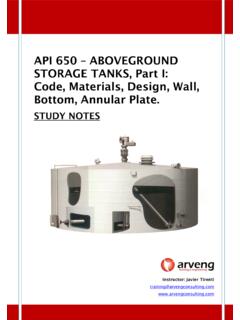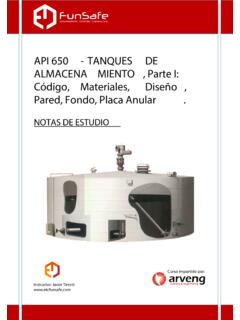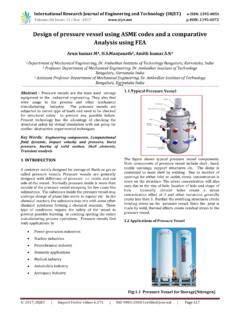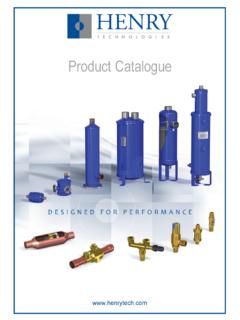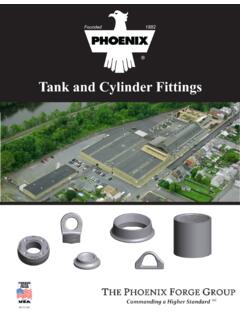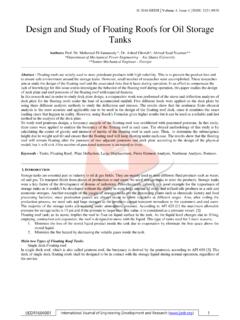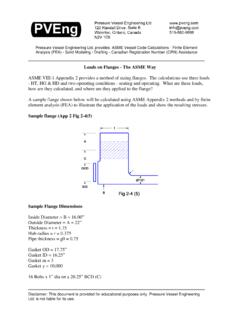Transcription of PRESSURE VESSELS, Part I: Pressure Vessel Design, Shell ...
1 PRESSURE VESSELS, Part I: PRESSURE Vessel Design, Shell , Head, Nozzle and Basic Flange STUDY NOTES Instructor: Javier Tirenti Training Projects Connecting Dots PRESSURE VESSELS ONLINE COURSE, Part I Instructor Javier 2 Table of contents Introduction .. 4 1. Design codes .. 8 ) Codes comparison .. 8 2. ASME BPVC Boiler and PRESSURE Vessel code .. 10 ) Historical review .. 10 ) BPVC Sections .. 11 ) Section VIII 12 3. ASME BPVC Section VIII, .. 14 ) Scope .. 14 ) Code organization .. 15 ) ASME stamp .. 18 ) Code revisions .. 19 4. Design conditions .. 21 ) Temperature .. 21 ) PRESSURE .. 21 ) Loads .. 23 ) Corrosion allowance .. 24 ) Wind, earthquake and snow .. 24 ) Hydro test .. 24 ) Multi-compartment equipment .. 24 ) Reference design books .. 25 5. Material selection .. 26 ) Corrosion .. 26 ) Essential properties of materials .. 31 ) Technical-economical selection .. 35 ) Materials designation.
2 36 ) Most used materials .. 37 6. Joint efficiency .. 40 ) Welded joints .. 41 ) Welded joint evaluation .. 45 ) Joint efficiency value .. 46 ) Selection charts .. 47 Training Projects Connecting Dots PRESSURE VESSELS ONLINE COURSE, Part I Instructor Javier 3 ) The full or spot dilemma .. 48 7. Design of parts under Internal PRESSURE .. 49 ) Cylindrical shells .. 49 ) Heads .. 52 8. Conical transitions under internal PRESSURE .. 56 ) Conical transitions (without knuckles & half apex angle < 30 ) .. 57 ) Toriconical transitions (knuckles radius > 6% of D) .. 59 9. Nozzles .. 61 ) Standard flanges .. 63 ) Gaskets .. 66 ) Nozzle necks .. 66 ) Reinforcement .. 69 10. References .. 77 Training Projects Connecting Dots PRESSURE VESSELS ONLINE COURSE, Part I Instructor Javier 4 Introduction A PRESSURE Vessel is considered as any closed Vessel that is capable of storing a pressurized fluid, either internal or external PRESSURE , regardless of their shape and dimensions.
3 The cylindrical vessels, to which we refer in this volume, are calculated on the principles of thin-walled cylinders. The first step in designing a container is choosing the best type for the service for which it is intended. The factors influencing the choice of type are the function of the container, the location, the nature of the fluid that has to be stored, the temperature and operating PRESSURE and their ability to store the volume needed by the process. PRESSURE vessels can be classified according to their intended service, temperature and PRESSURE , materials and geometry. Different types of PRESSURE vessels can be classified as follows: Training Projects Connecting Dots PRESSURE VESSELS ONLINE COURSE, Part I Instructor Javier 5 According to the intended use of the PRESSURE Vessel , they can be divided into storage containers and process vessels. The first classes are only used for storing fluids under PRESSURE , and in accordance with the service are known as storage tanks.
4 Process PRESSURE vessels have multiple and varied uses, among them we can mention heat exchangers, reactors, fractionating towers, distillation towers, etc. According to the shape, PRESSURE Vessel may be cylindrical or spherical. The former may be horizontal or vertical, and in some cases may have coils to increase or lower the temperature of the fluid. Spherical PRESSURE vessels are usually used as storage tanks, and are recommended for storing large volumes. Since the spherical shape is the "natural" form bodies adopt when subjected to internal PRESSURE , this would be the most economical way to store pressurized fluids. However, the manufacture of such containers is much more expensive compared with cylindrical containers. PRESSURE Vessel parts The following two sample vessels are presented: vertical and horizontal. In both cases the main parts are shown: Training Projects Connecting Dots PRESSURE VESSELS ONLINE COURSE, Part I Instructor Javier 6 Geometry definition To define the geometry of a PRESSURE Vessel , the inner diameter of the equipment and the distance between tangent lines is used.
5 The inner diameter should be used, since this is a process requirement. Training Projects Connecting Dots PRESSURE VESSELS ONLINE COURSE, Part I Instructor Javier 7 Welding line: point at which the head and Shell are welded Tangent line: point at which the curvature of the head begins Depending on the head fabrication method, heads come with a straight skirt. To set the length of the PRESSURE Vessel (regardless the type of heads), the distance between tangent lines is used since this distance is not dependent on the head manufacturing method. It is very rare that the weld and tangent lines coincide. Manufacturing sequence Training Projects Connecting Dots PRESSURE VESSELS ONLINE COURSE, Part I Instructor Javier 8 1. Design codes The purpose of using design codes is to avoid disasters that can affect humans. Therefore, they comprise a range of experiences and good practices. While there are several rules that apply, developed by countries with recognized technical expertise in the subject, the code that is the most internationally recognized and the most used is Section VIII " PRESSURE Vessels" part of the Boiler and PRESSURE Vessel Code (BPVC) of the American Society of Mechanical Engineers (ASME).
6 Other than the code above, the most commonly codes used for PRESSURE vessels are: Europe: EN-13445 Germany: A. D. Merkblatt Code United Kingdom: British Standards BS 5500 France: CODAP China: GB-150 The rules found in the design codes represent many years of experience. If used wisely, the code requirements can: Communicate design requirements Utilize know-how and technology Keep equipment costs low Reduce insurance costs Provide rules for the design of equipment adequate for design conditions determined by others. Do not provide rules or guidance for the determination of design conditions. Do not provide rules or guidance for the determination of the required material(s) of construction or corrosion allowance. Design scope of most design codes includes new construction only, not revamps, repairs or rerates. ) Codes comparison Provisions of a design code are an interrelated set of design, fabrication, inspection, and testing requirements.
7 For example, the use of a higher design stress may depend upon use of stringent material, analysis , examination, and testing requirements. Therefore, different codes can arrive at different resulting wall thickness yet have equivalent degrees of reliability. Training Projects Connecting Dots PRESSURE VESSELS ONLINE COURSE, Part I Instructor Javier 9 Training Projects Connecting Dots PRESSURE VESSELS ONLINE COURSE, Part I Instructor Javier 10 2. ASME BPVC Boiler and PRESSURE Vessel code ) Historical review By the end of the 18th century the use of boilers operating at pressures much higher than the atmospheric and the need to protect staff from faults, grew rapidly. In many cases, the result of operating boilers and vessels in those conditions were catastrophic. Several attempts were made to standardize the design criteria and calculation, but in 1911, due to the lack of uniformity in boiler fabrication, manufacturers and users of boilers and PRESSURE vessels requested advice to the ASME association to correct this situation.
8 Finally, in 1915, that association published the first ASME Boiler Code (now Section I) in the United States of America. The codes were established to provide manufacturing methods, records and report design data. Until 1930, when the first welded Vessel was manufactured, PRESSURE vessels and boilers were riveted. Joints were made "overlapping" the plates or using strips, placed on the joints, drilling and tightening the rivets. It was estimated that each rivet added PRESSURE in a certain influence area, thus guaranteeing the integrity of the equipment. Historically, engineers have applied the traditional strength of materials rules for designing PRESSURE vessels. They are still used today, but combined with: Nondestructive examination (NDE) Training Projects Connecting Dots PRESSURE VESSELS ONLINE COURSE, Part I Instructor Javier 11 Safety coefficients Lessons learned The aforementioned includes the classic design of PRESSURE vessels; nowadays checks according to finite Element analysis (FEA) are more and more extended with outstanding results, therefore we have to consider using this powerful tool in our designs if necessary.
9 BPVC Sections The ASME BVPC code is a set of standards, specifications, and design rules based on many years of experience, all applied to the design, fabrication, installation, inspection, and certification of PRESSURE vessels. It was created in the United States of America; several insurance companies demanded a design code in order to reduce losses and casualties. The ASME Boiler and PRESSURE Vessel is divided into the following sections: Those shown in the figure above are the twelve sections of the code. To properly design a PRESSURE Vessel , it is necessary to understand Section VIII of course, and additionally, the designer will need to be familiar with Sections II, V and IX. According to the scope of each section, the 12 parts can be grouped as follows: Construction codes: Sections I, III, IV, VIII, X & XII Reference codes: Sections II, V, IX Training Projects Connecting Dots PRESSURE VESSELS ONLINE COURSE, Part I Instructor Javier 12 Rules for operating, inspection and in service maintenance: Section VI & VII.
10 Section VIII Divisions The ASME Code Section VIII is a fabrication code. It contains mandatory requirements, specific prohibitions, and rules of construction and non-mandatory appendices. The code does not cover all possibilities related to these activities, therefore, aspects not specifically mentioned should not be considered prohibited. Anyway, who writes the design codes? The code is written by recognized people from different areas: academics, inspection agencies, owners, users, manufacturers of PRESSURE vessels and notified bodies among others. What is the most important aspect of the code? The most important aspect of the code is to know its organization and to know where to look things up. WHAT IS EVEN MORE IMPORTANT IS TO READ UNTIL THE END OF THE PARAGRAPH; EVEN THOUGH IT SEEMS AS IF WE HAVE FOUND WHAT WE WERE LOOKING FOR. There are 3 divisions in ASME Section VIII: divisions 1, 2 and 3.
